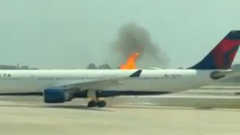While social media has increased awareness of air disasters, expert analysis indicates that aviation safety has improved over the last two decades, with a downward trend in accidents and fatalities compared to the rising volume of flights.
Air Travel Safety: Are Recent Crashes a Sign of Increased Risk?

Air Travel Safety: Are Recent Crashes a Sign of Increased Risk?
Experts clarify that despite public perception, air travel remains statistically safe amid recent high-profile accidents.
In recent weeks, a wave of alarming air incidents has raised questions among travelers about the safety of air travel. After numerous high-profile accidents, including a deadly mid-air collision and footage of planes struggling in severe weather, there is growing concern fueled by viral social media clips. US Transport Secretary Sean Duffy addressed these worries, assuring the public that these occurrences are "very unique" and do not represent a decline in aviation safety.
Data analysis by BBC Verify reveals that despite the recent surge in crash-related news, the overall trend in air accidents has been declining over the past twenty years. The National Transportation Safety Board (NTSB) has reported a reduction in air accidents within the United States from 2005 to the present, even as the number of flights has increased. For instance, the number of accidents reported in January 2025 (52) was lower than in January 2023 (70).
The International Civil Aviation Organisation (ICAO) has also tracked global aviation incidents, showing a similar downward trend per million plane departures. Although data from ICAO includes various types of accidents, including those that might not have serious injuries, it underscores the overall improvement in aviation safety. Significant spikes noted in the data, such as those caused by the disappearance of Malaysian Airlines flight MH370 in 2014, highlight the volatility attributed to singular historic events.
Experts like Prof Sir David Spiegelhalter from the University of Cambridge pointed out that fatality counts in aviation can change drastically due to isolated incidents, complicating perceptions of safety. "Random events do not occur evenly - they tend to cluster,” he explained, indicating that a series of tragedies can create the false impression of increased risk.
Former air disaster investigator Ismo Aaltonen reinforced this perspective, advising against drawing conclusions from the recent spate of accidents that have occurred over a short time. He remarked that many incidents were inherently unforeseeable, while other airline operations, including Azerbaijan Airlines, faced unique threats unrelated to overall safety.
Further complicating perceptions of air safety is the role of social media, which amplifies reports of aviation mishaps. An example includes a viral TikTok video that humorously portrays former US Transportation Secretary Pete Buttigieg amidst a series of reported plane troubles.
Despite these incidents, experts and regulatory bodies emphasize that commercial aviation remains the safest form of transportation available. Data from the US Department of Transportation indicates that over 95% of transport-related fatalities occurred on the roads in 2022, with less than 1% resulting from air travel. The safety comparison is even starker when considering fatalities per travel distance: only 0.001 passenger deaths per 100,000 miles traveled by air versus 0.54 in passenger vehicles.
In conclusion, with advancements in simulator technology and rigorous investigations following accidents, aviation safety protocols continue to evolve. Travelers are encouraged to focus on their journey to the airport, the most hazardous portion of their trip, rather than the flight itself. As the aviation industry strives for continual improvement, the statistical evidence reinforces that flying remains a remarkably safe choice.




















